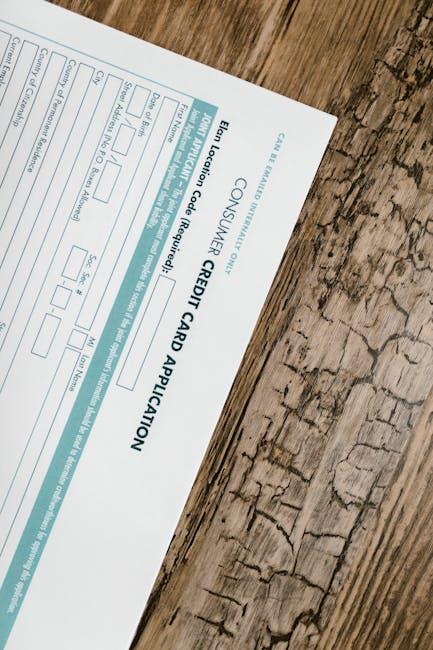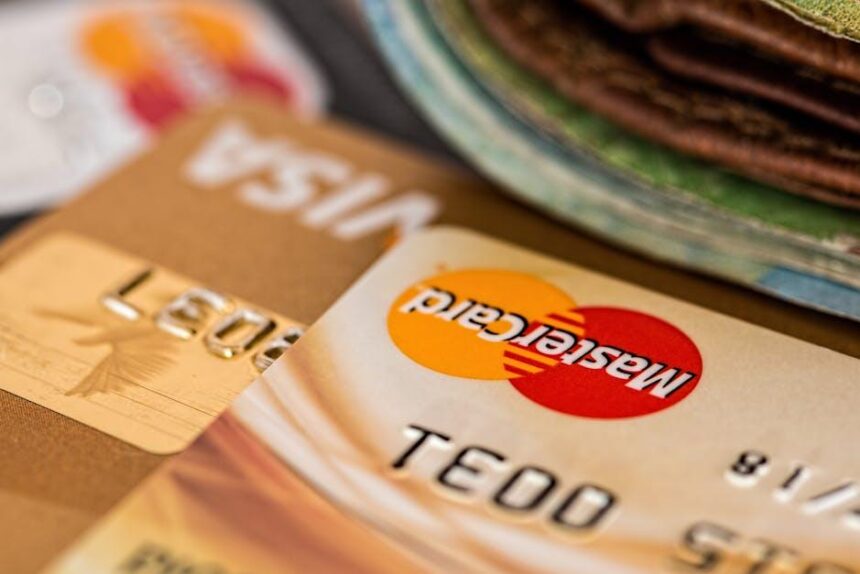Securing a credit card can be a pivotal step in your financial journey, especially if you’re looking to build or rebuild your credit history. A secured credit card, backed by a cash deposit, not only provides you with a financial tool for everyday purchases but also serves as a stepping stone towards better credit scores and borrowing opportunities. In this article, we will guide you through the essential steps to master the process of securing your secured credit card, empowering you to make informed decisions that align with your financial goals. Whether you’re a newcomer to credit or seeking to improve your standing, understanding the nuances of secured credit cards will set you on a path to financial confidence.
Understanding Secured Credit Cards and Their Benefits
Secured credit cards are specifically designed for individuals looking to build or repair their credit history. They operate similarly to traditional credit cards but require a security deposit as collateral, which serves as your credit limit. This means that if you deposit $500, your credit limit will also be $500.
Here are some key benefits of secured credit cards:
- Builds Credit History: Using a secured credit card responsibly helps you establish a positive credit history. As you make purchases and pay your bill on time, lenders report your activity to the major credit bureaus.
- Improves Credit Score: Consistently managing your secured card can help improve your credit score over time. It shows lenders that you can handle credit responsibly, making you more eligible for unsecured credit cards and loans in the future.
- Easier Approval: Secured credit cards are usually easier to obtain compared to traditional credit cards, especially for those with limited or poor credit histories.
- Controlled Spending: Since your credit limit is tied to your deposit, it encourages responsible spending habits. You won’t be able to spend more than you can afford, helping to avoid debt accumulation.
- Potential to Upgrade: Many secured cards offer the possibility of upgrading to an unsecured card after demonstrating responsible credit use. This can lead to improved terms and benefits.
When choosing a secured credit card, consider the following factors:
| Feature | Importance |
|---|---|
| Annual Fees | Look for cards with little to no fees, maximizing your usable credit. |
| Interest Rates | Check the APR; managing payments effectively can minimize interest costs. |
| Credit Reporting | Ensure the card issuer reports to all three major credit bureaus (TransUnion, Experian, Equifax). |
| Deposit Requirements | Understand the minimum deposit required and find a card that fits your budget. |
In summary, secured credit cards are a practical tool for those wishing to build or improve their credit scores. By understanding how they work and leveraging their benefits, you can pave the way for greater financial opportunities in the future.

Essential Steps for Selecting the Right Secured Credit Card
Choosing the right secured credit card can significantly impact your credit-building journey. Here are essential steps to guide you through the selection process:
- Evaluate Your Financial Goals: Understand why you want a secured credit card. Are you looking to build credit from scratch, repair your credit, or manage expenses more effectively? Your goals will dictate the features you prioritize.
- Compare Interest Rates: Look for cards with low Annual Percentage Rates (APRs). While secured cards typically have higher rates, you can still find competitive options. Pay attention to how interest rates will affect your balance if you carry it over month to month.
- Review Fees: Be aware of any associated fees, including annual fees, application fees, and maintenance fees. Some secured cards may have no annual fee, making them more appealing for budget-conscious consumers.
- Check Minimum Deposit Requirements: Different secured cards require different security deposits. Ensure you choose a card with a deposit that fits your budget. A larger deposit may translate to a higher credit limit, which can aid in credit growth.
- Look for Rewards and Benefits: Some secured credit cards offer rewards, such as cash back or points, on purchases. For example, the Discover it® Secured Credit Card provides cash back on all purchases, making it a worthwhile consideration [[1]]
- Research Issuer Reputation: Choose cards from reputable and established banks or financial institutions. Read customer reviews and check ratings to ensure you’re partnering with a trustworthy issuer.
- Understand Transition Policies: Investigate how and when a secured card can transition to an unsecured card. Some issuers may automatically review your account after a set period, allowing you to upgrade without losing your credit history.
- Consider Online Management Tools: A user-friendly mobile app or web interface can enhance your banking experience. Look for a card that allows you to track spending, make payments, and view statements with ease.
- Analyze Customer Support Options: Good customer service is crucial. Ensure that the issuer offers accessible support channels for any inquiries or issues you might have.
By carefully considering these elements, you can confidently select a secured credit card that aligns with your financial goals and paves the way for a stronger credit future.

Building Credit Wisely: Strategies for Responsible Use
Building credit wisely is essential for establishing a solid financial future. Here are some practical strategies to help you use your secured credit card responsibly and improve your credit score over time:
- Make On-Time Payments: Always pay your credit card bill on or before the due date. Late payments can significantly impact your credit score and lead to added fees.
- Keep Balances Low: Aim to use less than 30% of your available credit limit. High utilization rates can negatively affect your credit score. For example, if your secured credit card has a limit of $500, try to keep your balance below $150.
- Set Up Automatic Payments: To ensure you never miss a payment, consider setting up automatic payments for at least the minimum amount due. This can also help you avoid late fees.
- Review Your Statements: Regularly check your credit card statements for any errors or unauthorized transactions. If you spot any issues, report them immediately to your card issuer.
- Limit New Credit Applications: Each time you apply for credit, a hard inquiry is made on your credit report, which can ding your score. Space out credit applications and only apply when necessary.
- Use Your Card Responsibly: Use your secured credit card for small, manageable purchases that you can pay off each month. This demonstrates responsible usage to creditors.
Monitoring your credit progress is equally important. Consider using resources such as free credit monitoring services or apps provided by banks. These services allow you to track changes in your credit score and understand the factors influencing it.
| Action | Benefit |
|---|---|
| On-Time Payments | Builds a positive payment history, boosting your score. |
| Low Balances | Improves your credit utilization ratio, enhancing your score. |
| Automatic Payments | Reduces the risk of late payments. |
| Monitor Statements | Identifies errors quickly, helping maintain a good score. |
| Limit Inquiries | Avoids significant drops in your credit score. |
| Responsible Usage | Shows lenders you can manage credit effectively. |
By following these strategies, you can use your secured credit card not just as a tool for building credit but also as a stepping stone to financial stability. Each responsible action you take contributes to a stronger credit profile, setting you up for future opportunities.

Monitoring Your Progress and Advancing to Unsecured Options
As you begin your journey with a secured credit card, it’s crucial to keep a close eye on your credit progress. Monitoring your credit profile not only helps you understand where you stand but also prepares you for transitioning to unsecured credit options, which can provide greater flexibility and benefits.
Here are some effective ways to monitor your credit progress:
- Regularly Check Your Credit Reports: Obtain free copies of your credit reports annually from AnnualCreditReport.com. Look for inaccuracies and understand your credit utilization ratio.
- Use Credit Monitoring Services: Many services offer real-time updates on your credit score and alert you to changes. This proactive approach allows you to act quickly if your score drops.
- Track Your Payment History: Ensure you consistently make on-time payments, as payment history accounts for a significant portion of your credit score.
- Watch Your Credit Utilization: Aim to keep your credit utilization below 30% of your total limit. This indicates to lenders that you use credit responsibly.
After monitoring and seeing consistent improvement in your credit score, it may be time to consider moving to an unsecured credit card. Here are some signs you might be ready:
- Your credit score has improved significantly (typically above 650).
- You have established a solid payment history with no missed payments over the last 6-12 months.
- You have reduced your overall debt-to-income ratio.
- You understand the terms and features of unsecured cards, including fees and interest rates.
When applying for an unsecured credit card, keep in mind the following steps:
| Step | Description |
|---|---|
| Research Options | Compare different cards to find the best benefits, rates, and terms that suit your needs. |
| Check Your Credit Score | Confirm your score is at a level acceptable for unsecured credit cards. |
| Gather Documentation | Prepare necessary documents such as proof of income and identification. |
| Complete the Application | Fill out the application carefully, ensuring accuracy to avoid delays. |
Transitioning from a secured card to an unsecured option can significantly enhance your credit profile. By diligently monitoring your progress, you’ll be well-equipped to make informed financial decisions and take advantage of better credit opportunities available to you.

To Conclude
As you embark on your journey to secure a secured credit card, remember that the path to building or rebuilding your credit is paved with commitment and responsible financial habits. Each step you take not only enhances your credit score but also empowers you to take control of your financial future. So, gather your resources, make that deposit, and watch as your diligent efforts unfold into lasting credit opportunities. Mastering this process isn’t just about obtaining a card; it’s about laying the foundation for a prosperous financial life. Start today, and unlock the potential that a secured credit card can bring.














